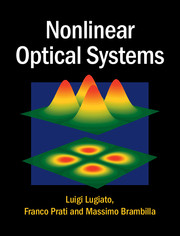Book contents
- Frontmatter
- Dedication
- Contents
- Preface
- Part I Models, propagation, stationary phenomena
- 1 The rate-equation model for the laser
- 2 The interaction of a system of two-level atoms with the electromagnetic field
- 3 The Maxwell–Bloch equations
- 4 Inclusion of the irreversible processes in the atomic equations
- 5 Propagation in irreversible Maxwell–Bloch equations
- 6 Optical nonlinearities. Materials with quadratic nonlinearities
- 7 Optical nonlinearities. Materials with cubic nonlinearities
- 8 Optical resonators. The planar ring cavity. Empty cavity. Linear cavity
- 9 A nonlinear active ring cavity: the ring laser, stationary states
- 10 The adiabatic elimination principle
- 11 A nonlinear passive ring cavity: optical bistability
- 12 Modal equations for the ring cavity. The single-mode model
- 13 Single- and two-mode models
- 14 Nonlinear dynamics in Fabry–Perot cavities
- 15 Inhomogeneous broadening
- 16 The semiconductor laser
- 17 Lasers without inversion and the effects of atomic coherence
- Part II Dynamical Phenomena, Instabilities, Chaos
- Part III Transverse optical patterns
- Appendix A The Routh–Hurwitz stability criterion
- Appendix B Calculation of the oscillatory instability boundary
- Appendix C Coefficients of the characteristic equation (20.20)
- Appendix D Derivation of equations (20.27) and (20.28)
- Appendix E Coefficients of equations (20.60) and (20.61)
- Appendix F The exact boundary of the Risken–Nummedal–Graham–Haken instability
- Appendix G Nonlinear analysis of the roll solution
- References
- Index
6 - Optical nonlinearities. Materials with quadratic nonlinearities
from Part I - Models, propagation, stationary phenomena
Published online by Cambridge University Press: 05 March 2015
- Frontmatter
- Dedication
- Contents
- Preface
- Part I Models, propagation, stationary phenomena
- 1 The rate-equation model for the laser
- 2 The interaction of a system of two-level atoms with the electromagnetic field
- 3 The Maxwell–Bloch equations
- 4 Inclusion of the irreversible processes in the atomic equations
- 5 Propagation in irreversible Maxwell–Bloch equations
- 6 Optical nonlinearities. Materials with quadratic nonlinearities
- 7 Optical nonlinearities. Materials with cubic nonlinearities
- 8 Optical resonators. The planar ring cavity. Empty cavity. Linear cavity
- 9 A nonlinear active ring cavity: the ring laser, stationary states
- 10 The adiabatic elimination principle
- 11 A nonlinear passive ring cavity: optical bistability
- 12 Modal equations for the ring cavity. The single-mode model
- 13 Single- and two-mode models
- 14 Nonlinear dynamics in Fabry–Perot cavities
- 15 Inhomogeneous broadening
- 16 The semiconductor laser
- 17 Lasers without inversion and the effects of atomic coherence
- Part II Dynamical Phenomena, Instabilities, Chaos
- Part III Transverse optical patterns
- Appendix A The Routh–Hurwitz stability criterion
- Appendix B Calculation of the oscillatory instability boundary
- Appendix C Coefficients of the characteristic equation (20.20)
- Appendix D Derivation of equations (20.27) and (20.28)
- Appendix E Coefficients of equations (20.60) and (20.61)
- Appendix F The exact boundary of the Risken–Nummedal–Graham–Haken instability
- Appendix G Nonlinear analysis of the roll solution
- References
- Index
Summary
In the previous chapter we examined nonlinear propagation in a two-level medium, which leads to amplification or absorption of the radiation field. As we will see further on in this volume, when the medium is placed in an optical cavity one realizes a laser in the case of amplification or an optically bistable system in the absorptive configuration. On the other hand, the nonlinear response of the atomic polarization to the electric field leads to further fascinating scenarios [29, 51–60]. For example, a field with central ω0 can generate harmonic components with central frequencies 2ω0, 3ω0 etc., processes that are called second-harmonic generation, third-harmonic generation etc. Furthermore, the interaction of two fields with central frequencies ω1 and ω2, with ω1 > ω2, can generate components with central frequency ω1 + ω2 (sum-frequency generation) and ω1 − ω2 (difference-frequency generation). Such phenomena have not yet appeared in this volume because we have assumed that the electric field corresponds to a narrow frequency band around a central frequency ω0 only, whereas to describe them it is necessary to assume that the electric field is the superposition of a number of frequency bands. In this chapter we will provide a description of the basic elements which are necessary to describe these phenomena and we will discuss a small number of them for the case of materials with a quadratic nonlinearity, referring to textbooks in nonlinear optics for the description of other phenomena. The following chapter is devoted, instead, to the case of materials with cubic nonlinearities.
The starting point of nonlinear optics is the expansion of the atomic polarization in powers of the electric field, when the electric field is not too intense. In our treatment in Chapter 5 we saw that the expansion of the nonlinear susceptibility contains only even powers of the electric field (see Eq. (5.27)), and therefore the expansion of the polarization includes only odd powers.
- Type
- Chapter
- Information
- Nonlinear Optical Systems , pp. 60 - 73Publisher: Cambridge University PressPrint publication year: 2015



